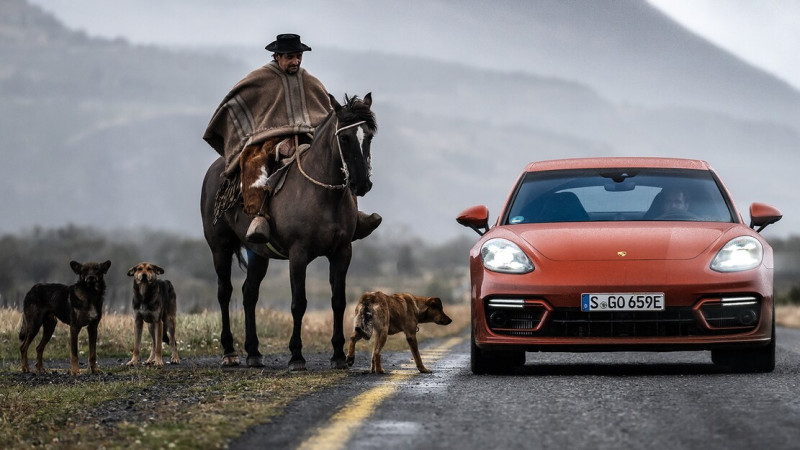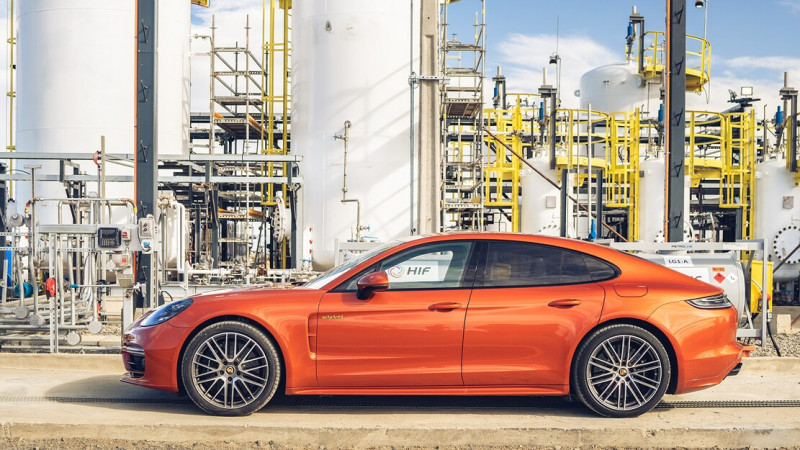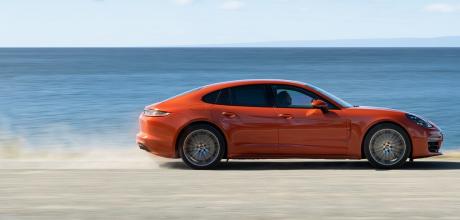Across Chile by 2024 Porsche Panamera 971 - testing e-fuel to the end of the world
Porsche believes that e-fuel will keep the internal combustion engine alive in an electrified future. Steve Sutcliffe travels to Chile to find out how.
Photography Porsche
Can e-fuels save the world? Turns out that it’s a 74-million-dollar question. And the answer? On their own, probably not. But as part of a midterm solution to the increasingly thorny issue of climate change, e-fuels can no longer be ignored.

So although they can’t quite be hailed as a miracle cure for the ‘hangover to end all hangovers’ we’ve inflicted upon ourselves courtesy of the industrial revolution, they’re probably the most realistic chance we’ve got of not completely mucking it all up during the next 10-15 years. And for internal combustion engine enthusiasts especially, they are pretty much the only way forwards, longer-term.
Without e-fuels it’s not unduly dramatic to say it’ll be game over for the combustion engine in ten years’ time because, if nothing else changes by then, ICE vehicles will be legislated into a dusty toy box for eternity.

But if e-fuels are adopted quickly and globally, we might just have a chance. We might even be able to continue driving our beloved ICE cars not just for the next 10-15 years but — if they’re embraced in the way they should be — virtually forever. This, you’ll agree, would be A Very Good Thing Indeed.
But do e-fuels honestly contain this much raw potential? In a word, yes, because in the simplest terms an e-fuel takes as much CO2 out of the atmosphere during its creation as it puts back in when it’s being burned. And that really is the crux of the matter, beyond which are myriad other reasons to justify its importance but none so important as this: the simple fact that you take out what you put back in.
To use Porsche’s parlance, this means e-fuel is ‘virtually carbon neutral’. Indeed, in ICE cars that emit less than about 100 grams of CO2 per kilometre, the process is closer to being carbon-negative than it is carbon neutral, which makes it a very big win — in theory — although inevitably there are caveats, some of which are more important than others, all of which I’ll come to in a while.
In the meantime, what’s Porsche’s involvement with e-fuel? And is the stuff it’s now producing at the shiny new plant I’ve just visited in southernmost Chile in any way superior to, or just different from, the e-fuels and biomass fuels already being made by the likes of Sustain, Pl, Coryton, BOSH and so on?
In truth, biomass, e-fuels and synthetic fuels are much the same thing in fundamental terms: biomass fuels use CO2 created from fermentation whereas e-fuels use captured’ carbon dioxide, sometimes from places such as beer factories or, in Porsche’s case, from the atmosphere, which is when some serious voodoo takes place. But in all cases you end up with a broadly similar result: a fuel that’s usable in combustion-engines without having to mine or set fire to any fossils.
The main differences between the various types are in the efficiency of their production processes (biomass fuels tend to require more raw renewables to make than synthetic fuels, with e-fuel being theoretically the best of all) and in their capacity to then be scaled-up. Porsche’s e-fuel is more readily scaled-up than any other, so the company claims, but inevitably Porsche’s connection with e-fuel is complex, as in not remotely straightforward.
Read the headlines put out by the company’s own PR machine and you could be forgiven for thinking e-fuel is a ‘Porsche saves the world’ technological breakthrough. In reality, Porsche is mostly just acting as the charismatic frontman to a project that’s predominantly being financed and engineered by the traditional oil and gas industries. Partly out of guilt, perhaps, but also due to an acute awareness that conventional gasoline sales are heading in one direction only from now on.
Either way, and whoever it’s being made by (again, more on this in a bit), e-fuels could be our only hope until full-blown electrification takes over as the main method of propulsion for the world’s cars, trucks and planes, if not its ships, which are more complex to fuel and probably require a hybrid of solutions due to their weight. In realistic terms, the electrification of our transport systems is not going to happen for at least the next ten years — probably a lot longer on a global scale — which leaves an almighty gap to plug between now and whenever that happens.
Today, there are approximately l.Zbillion ICE vehicles on our roads, and even if that number halves by 2033 (which it most likely won’t) it will still mean hundreds of millions of combustion engines will be burning fuel in ten years’ time, most of them on a daily basis. Yet according to the overwhelming scientific evidence, we can’t afford to keep churning CO2 into the atmosphere at anything like the rate we already are, not even for five years let alone the next ten, otherwise Armageddon looms.
So we need a solution, and we need it fast, and e-fuels might well be it so long as a) they are approved rather than legislated against by governments internationally, b) their manufacture and distribution are financed at least partly by those same governments, c) they aren’t just discarded by environmentalists as a means by which the evil car enthusiast can continue to ‘get away with it’ while everyone else suffers. And d) their cost becomes more realistic as a result of points a-to-c actually happening within the next 18 months, but no later than that. That’s how urgent the situation has become, according to the science.
There are numerous ways in which you can justify e-fuels, but maybe the biggest selling point of the one Porsche is putting its name to is that it can be scaled-up simply and quickly, then distributed globally from plant to pump via the exact same network of forecourts and lorries that are used today. It can even be mixed as a ‘drop in’ with conventional gasoline if needs be, plus its octane rating can be tweaked post-production to suit whatever vehicle you wish to use it in — be that a Ford Model T, a 911 GT3 RS or a commercial jet aeroplane.
It can also be made locally wherever there’s a strong and consistent enough source of wind to power a turbine 24 hours a day — as there is in southernmost Chile — in which case its carbon footprint improves still further: the shorter the journey it to has to make from plant to pump, the stronger the case for it gets.
The ideal power source for a fully scaled-up e-fuel plant is on-shore wind; off-shore windfarms are way more expensive to maintain and harness energy from, although they can still be made to work if scaled-up sufficiently, reckon Porsche’s experts.
Solar energy can also provide power for an e-fuel plant, but the sun goes down every 24 hours, which means the collected energy needs to be stored during darkness if solar is going to provide a constant source of power on an industrial scale, and that’s nowhere near as efficient as a wind turbine that’s always being blown by the wind. So geographically your (ideal) options are limited to large, remote chunks of land where the population density is low, where the wind blows hard and, as The Kinks once sang, ‘all day, and all of the night’. Hence current plans to expand the Chilean plant on a mass scale and build industrial-sized plants in both Texas and Tasmania.
The Chilean plant might only be a demonstration of what’s possible to achieve right now but, of the $74million it’s cost to build, almost $55m of that has come from a company called AME (Andes Mining Energy), which has made its money out of coal mining over the years, even though latterly it’s moved into the wind turbine business as well.
Only 12% of the total spend on the Haru Oni plant has been put up by Porsche, in fact, so even though Porsche’s outright investment in e-fuel is, you guessed it, $74m — that’s how much it’s sunk into HIF (Highly Innovative Fuels), the company that built the plant and which will produce its e-fuel globally, assuming it takes-off — in overall terms it is not a main investor. Far from it.
Exxon-Mobil, on the other hand, very much is, albeit quietly; its investment percentage in HIF isn’t even stated officially. Yet Exxon provides by far the most expensive and complex piece of technology at the Haru Oni plant: a vast and foreboding room full of aluminium tubes and tanks plus a quite extraordinary array of gauges, all of which is collectively referred to as ‘the room where the magic happens’ by Porsche’s e-fuel experts.
What happens in ‘the Exxon room’ is a process known as MTG (‘methanol to gasoline’) in which the e-methanol that’s produced by the plant’s renewable sources (wind and water, which we’ll also come to in a bit) is mixed with catalysers to eventually produce raw 93-octane e-fuel. This can then be tweaked using non-fossil additives to achieve whatever octane rating is required.
Before any of that happens, however, energy is harnessed purely from the wind by a 3.4-megawatt turbine, which powers the plant’s three electrolysers into which water is fed and then split into hydrogen and oxygen (H2 and O2). The oxygen is vented back into the air because it’s not needed; the hydrogen is mixed with CO2 that’s been extracted from the atmosphere using HIF’s new ‘carbon capture technology’ — arguably the most relevant part of the process because it removes CO2 from the atmosphere, hence the ‘take out what we put back in’ claim — to generate e-methanol, which then goes through the MTG process. This e-methanol forms the basis of whatever fuel you wish then to create, from regular 95-octane e-fuel via e-diesel to e-Kerosene jet-fuel.
This highly complex hunk of chemistry (the MTG machine) was originally developed by Exxon-Mobil to convert flare gas at its refineries in New Zealand in the 1980s, but was abandoned soon afterwards because it was deemed ‘uneconomical’ at the time. Back then, Exxon developed lots of good technologies to compensate for the emissions it knew it was producing but then buried much of it ‘due to economic reasons’. Anyway, the key thing is it’s been fired back up again in 2023 (no pun intended — well, not really) to help HIF and Porsche generate e-fuel because the world is in a bit more trouble this time round.
Which brings us to the thorniest issue of all concerning e-fuel: its price, and the fact that it’s always going to be prohibitively expensive unless we embrace it on a global scale. At the moment we’re talking around £8-10 a litre, so £40-45 a gallon. But don’t let that put you off the idea terminally because, today, a thimble of e-fuel is rarer than a bottle of Chateau Lafite 1961. The price of anything is always relative to its supply and, if e-fuel takes off, its supply will improve — and its price will fall. That’s the theory being punted by Porsche, at any rate.
So what does it feel like to drive a car that’s running on Porsche e-fuel — the same, different, better or worse than the same car running on regular unleaded? Well, once I’d done a tour of the plant in Chile and been bamboozled, stunned, impressed and downright petrified by the science behind it in equal measure, Porsche handed me the keys to a Panamera Turbo S and invited me to drive it along the famous End of The World Road, having filled it with 50 litres (approximately $500) of e-fuel. So I drove it for several hundred miles.
The scenery was incredible, the roads endlessly long and straight, and not wellsurfaced for much of the time. I saw pumas and condors and drove for hours on end across some of the bleakest, most beautifully untouched landscapes you could ever wish to visit. And every time I stopped for a comfort break or just got out to take a good look around, the door of the Panamera would be flung open violently on the wind. Because it’s there all day and all of the night: it never ceases. It is the very reason why Porsche and HIP and Exxon Mobil and all the other investors in e-fuel have alighted here in the first place: to harness the power of a wind that never goes away.
And unless they’re all fibbing collaboratively on a truly grand scale, it works. The twin-turbo V8 Panamera drove identically on the e-fuel it had been filled with on day one to the way it did running on the conventional unleaded it was topped up with on day two. There really was zero difference. That felt like a gigantic realisation at the time but only because there was no perceptible change. Same fuel consumption, same emissions, same feel to the throttle, same car.
The difference is that on day one it ran on a fuel that had been manufactured in such a way that it had already taken out most of the CO2 which its V8 then put back into the atmosphere — while on day two it was a one-way street.
That’s a potentially life-altering difference, one that could mean it’s still possible to execute a U-turn and alter our trajectory even at this late stage, even on the Ruta del Fin del Mundo. Assuming, that is, our rule-makers and big industries — all of us — are prepared to compromise and, for once, do the right thing.
We got ourselves into this mess in the first place, after all. Now it’s up to us — and them — to put things right. And e-fuel is most definitely part of the solution.
‘E-FUEL CAN BE MADE WHEREVER THERE’S A SOURCE OF WIND 24 HOURS A DAY’
‘E-FUELS COULD BE OUR ONLY HOPE UNTIL ELECTRICITY TAKES OVER AS THE MAIN METHOD OF PROPULSION’
Above and right Wind is in plentiful supply in Chile, which makes it an ideal location for the production of e-fuel; Sutcliffe tests an e-fuel-powered Panamera on Chile's End of The World Road.


